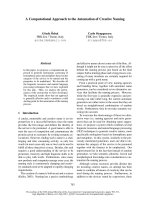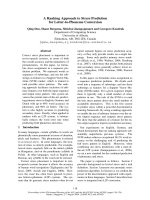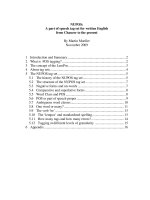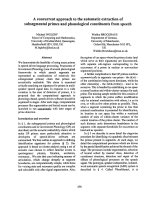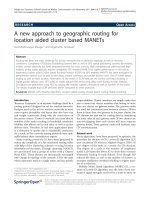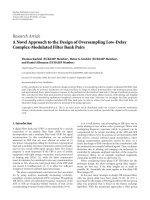A combinatorial approach to the search for anticonvulsant agents from gou teng and tian ma
Bạn đang xem bản rút gọn của tài liệu. Xem và tải ngay bản đầy đủ của tài liệu tại đây (2.12 MB, 195 trang )
A COMBINATORIAL APPROACH TO THE SEARCH
FOR ANTICONVULSANT AGENTS FROM GOU TENG
AND TIAN MA
YANG HONG
(B. Sc. (Pharm.)), Sichuan Univ.
(M. Sc. (Pharm.)), Sichuan Univ.
A THESIS SUBMITTED
FOR THE DEGREE OF DOCTOR OF PHILOSOPHY
DEPARTMENT OF PHARMACY
NATIONAL UNIVERSITY OF SINGAPORE
2009
i
ACKNOWLEDGEMENTS
I would like to give my sincere gratitude to my dear supervisor, Assoc. Prof. Chui
Wai Keung. What I have learned besides his gentleness, kindness and generosity is
the attitude towards scientific research, meticulous, skeptical and always open-
minded. I think I am lucky enough to be his student, who has been granted such a
great freedom to experiment with wild ideas, guided not to lose the direction while
exploring, and encouraged to confidently convey research findings in oral
presentation. I hope I would be growing up as an independent researcher, since that
will be the best gift a student could think of to give to her teacher.
I would also like to thank Dr. Low Chian Ming, who helped me to plan my
electrophysiological study and initiated so many insightful discussions regarding the
results, Dr. Chew Eng Hui, who gave me valuable advice and shared with me her
experiences in culturing cell lines, and Mr. Wee Xi Kai, who taught me how to use
autodock program.
I am grateful to the Pharmacy department lab technicians namely, Ms Ng Sek Eng,
Ms Dyah Nanik Irawati and Ms Lye Pey Pey, for all your hard work in providing
technical support. More importantly, I wish to express my deep gratitude to National
University of Singapore for offering the research scholarship that supports my
candidature. In addition, I would like to acknowledge the academic research grant
(R148-000-049-112) for providing financial resources for the work carried out.
My dear friends, Dr. Ma Xiang, Ms Pauline Ong, Ms Michelle Kok, Dr. Huang Meng,
Ms Wang Chunxia, Mr. Zhang Yaochun, Ms Jin Jing, Ms Yang Shili, Mr. Wang Zhe
and Ms Sim Hong May, I owe you all a big thank you. You all know how I can easily
cry but you may not know I only cried in front of friends. The time spent with you
was so precious and would be preserved in my memories.
My dear parents and sister, I am indebted to all of you for being my first teachers and
my best companions ever. My dearest husband, Mr. Lu Xiaohua, you have fulfilled
my life outside the lab, and I am thanking you for always being there for me,
appreciating me as I am in spite of my ill-temper and willfulness. This thesis is
written for you.
ii
CONTENTS
PAGE
ACKNOWLEDGEMENTS i
CONTENTS ii
SUMMARY v
ABBREVIATIONS vii
LIST OF SCHEMES xi
LIST OF FIGURES xii
LIST OF TABLES xv
1. INTRODUCTION 1
1.1. General introduction 1
1.2. Drug discovery from natural products 2
1.2.1. Crude, pre-fractionated and pure natural products library 5
1.2.2. The reductionist and holistic approach in drug discovery from natural
products 10
1.2.2.1. Interplay between constituent in natural products 10
1.2.2.2. Bioassay-guided fractionation and systems biology based
metabolomic approach 13
1.2.3. A proposition-purifying one single chemical class from natural
products 16
1.2.4. Hyphenated instrumentation applied in the analysis of natural products
18
1.3. Two traditional Chinese Medicines – Gou Teng & Tian Ma 21
1.3.1. Phytochemical and pharmacological studies of Gou Teng 21
1.3.2. Phytochemical and pharmacological studies Tian Ma 26
1.4. Antiepilepsy, antiepileptogenesis and neuroprotection 28
1.4.1. Definition for antiepilepsy, antiepileptogenesis and neuroprotection29
1.4.2. In vitro & in vivo models for epilepsy, epileptogenesis and
neuroprotection 30
1.5. The role of NMDA antagonism in antiepilepsy, antiepileptogenesis and
neuroprotection 33
1.5.1. NMDA antagonism 33
1.5.2. Antagonists at the glycine site of NMDA receptor 34
1.6. Summary 39
1.7. Hypothesis and objectives 40
2. RESULTS & DISCUSSIONS 43
2.1. The standardized extracts derived from Gou Teng and Tian Ma 43
2.1.1. Methodology 43
2.1.2. The standardized alkaloidal extract from Gou Teng 44
2.1.2.1. Preparation of the alkaloidal extract 45
iii
2.1.2.2. Qualitative analysis of the alkaloidal extract by LC-ESI-MS 46
2.1.2.3. Isolation and characterization of single alkaloids from the
alkaloidal extract 48
2.1.2.4. Quantitative analysis of the alkaloidal extract by LC-UV 56
2.1.2.5. Conclusions 60
2.1.3. The standardized phenolic extract derived from Tian Ma 62
2.1.3.1. The preliminary purification and analysis on GC-EI-MS 63
2.1.3.2. Isolation and characterization of single phenolic compounds in
the EFME 70
2.1.3.3. Synthesis of some phenolic compounds present in Tian Ma 73
2.1.3.3.1. Retro-synthesis of target compounds 74
2.1.3.3.2. Synthesis of HPMP 75
2.1.3.3.3. Synthesis of BHE, HFC and CSD 79
2.1.3.3.4. Synthesis of HMP 81
2.1.3.4. Further purification on MAX cartridge and analysis on LC-UV
82
2.1.3.5. Conclusions 84
2.1.4. Summary 85
2.2. Antiepileptic activity investigation 85
2.2.1. MES and rotorod test 85
2.2.2. Implications for the results of the phytochemical and animal study 91
2.2.2.1. Justifications for choosing the strategy of the purification of the
alkaloids and phenols over bioassay-guided fractionation 91
2.2.2.2. Explanations for the lack of antiepileptic activity possessed by
the alkaloidal and phenolic extracts 93
2.3. In vitro neuroprotective activity assessed on neuro-cell line 95
2.3.1. Effects on cell viability in the absence of neurotoxins 96
2.3.2. Effects on cell viability in the presence of hydrogen peroxide 98
2.3.3. Effects on cell viability in the serum-deprived medium 99
2.4. Design and synthesis of potential antagonists at Gly/NMDA receptor and in
vivo neuroprotective activity 103
2.4.1. Design of novel antagonists of Gly/NMDAR 103
2.4.2. Synthesis of 2-oxindole derivatives 107
2.4.2.1. Synthesis of 3-[(substituted furan-2-yl)methylidenyl] 2-oxindoles
107
2.4.2.2. Synthesis of substituted-3-benzoyl (furoyl)-2-oxindoles 110
2.4.3. Neuroprotective activity evaluation on SH-SY5Yneuroblastoma cell
line 115
2.4.3.1. Effects of 2-oxindole derivatives on cell viability in the absence
of neurotoxins 115
2.4.3.2. Effects of 2-oxindole derivatives on cell viability in the presence
of hydrogen peroxide 116
2.4.3.3. DPPH free radical scavenging test 118
2.4.4. Electrophysiological characterization of 3112 on Xenopus oocytes
expressing NR1/NR2B 120
2.4.5. Conclusions 125
3. CONCLUDING REMARKS 127
4. EXPERIMENTAL 134
4.1. General 134
4.2. Phytochemistry 135
iv
4.2.1. Prepare the standardized extracts 135
4.2.1.1. The alkaloidal extract from Gou Teng 135
4.2.1.2. The phenolic extract from Tian Ma 135
4.2.2. Instrumental analysis of the extracts 136
4.2.2.1. Qualitative analysis of the alkaloidal extract by LC-ESI-MS 136
4.2.2.2. Quantitative analysis of the alkaloidal extract by LC-DAD 137
4.2.2.3. Qualitative analysis of the EFME by GC-EI-MS 137
4.2.2.4. Quantitative analysis of the EFME by LC-DAD 138
4.2.3. Spectroscopic analysis of the isolated compounds 139
4.3. Computational method – Molecular docking 142
4.4. Synthetic chemistry 143
4.4.1. Synthetic procedures 143
4.4.2. Characterization data of synthesized compounds 149
4.4.3. X-ray crystallographic analysis of compound 18 162
4.5. Bioactivity investigations 163
4.5.1. DPPH free radical scavenging test 163
4.5.2. Determination of total free phenolic compounds by Folin-Ciocalteu
test 164
4.5.3. MES and Rotorod test 164
4.5.4. Cell culture and cell viability test 165
4.5.5. Electrophysiological study of compound 20 (3112) on Xenopus
oocytes expressing NR1/NR2B 166
4.5.6. Statistics 167
5. BIBILIOGRAPHY 168
v
SUMMARY
Although current antiepileptic drugs can effectively relieve most of the epileptic
patients from episodes of seizure, still 40% of the patients are refractory to the current
therapeutics. Hence development of new antiepileptic agents is urgently needed. Gou
Teng and Tian Ma are two well-known Traditional Chinese Medicines (TCMs),
widely used in oriental medicine to treat epilepsy, hypertension and migraine, but
their scientific evidences to support their therapeutic applications in the above-
mentioned areas are limited. NMDA (N-methyl-D-aspartic acid) antagonism is an
important mechanism for many successful antiepileptic and neuroprotective agents,
such as MK-801, CPP, ketamine etc. Nowadays NMDA receptor antagonism still
remains as an effective strategy for discovery of new antiepileptic and neuroprotective
agents. Our aim is to search for active small molecules or molecular combinations
from Gou Teng and Tian Ma, and to design and synthesize new NMDA receptor
antagonists for the benefit of controlling seizures and protecting against neuronal
damages.
Conventional extraction and purification techniques were employed to obtain
bioactive fractions, which were subsequently subjected to careful qualitative and
quantitative chemical analysis. The standardized fractions, derived from Gou Teng
and Tian Ma respectively, were tested on the maximal electroshock-induced seizure
(MES) model in mice and on cell cultures that were inflicted by either hydrogen
peroxide or serum-deprivation. The indole-2-one (2-oxindole) template was utilized
to prepare a series of 3-substituted derivatives which were later tested on cell cultures
inflicted by hydrogen peroxide and on voltage-clamped Xenopus Oocytes expressed
NR1/NR2B NMDA receptor.
vi
The acquired fractions either alone or in combination did not prevent MES induced
seizure activities on mice, but the phenolic fraction derived from Tian Ma was found
to be rescuing cells from serum-withdrawal induced apoptosis. Two libraries based on
2-oxindole derivatives were synthesized with acceptable yields, and one of the
libraries was found to be acting as free radical scavengers to protect against cell death
inflicted by hydrogen peroxide. One synthesized compound, namely compound 20
(3112), was found to be a weak agonist acting at the glycine site of NMDA receptor
based on the electrophysiological study on Xenopus Oocytes. Therefore, in this
project it was found that Gou Teng and Tian Ma might be used more as
neuroprotectants rather than as antiepileptic agents. In addition, some of the
synthesized 2-oxindole derivatives that were initially designed as antagonists of
Gly/NMDAR were acting as neuroprotectants against oxidative stress.
In this project, the endeavour to search for potential antiepileptic and neuroprotective
agents was made on both natural products and synthetic compounds. NMDA
antagonism which was one of the mechanisms for Gou Teng to protect neuronal
damage and also the rational basis on which the 2-oxindoles were synthesized served
as the link. This was a trial that combined the passive process of isolating constituents
from natural products and the active participation of design and synthesis of new
compounds based on a well-defined target; this was an experiment that combined the
diversified structures found in natural products and the synthetic library with limited
structure diversity. It was believed that the most fruitful discovery of drugs should
rely on both natural products and organic synthesis.
Key words: Antiepileptic agents; Gou Teng (Ramulus Uncariae cum uncis); Tian Ma
(Rhizoma Gastrodiae); NMDA receptor; 2-oxindole derivatives.
vii
ABBREVIATIONS
2CI 2-Carboxyindoles
4HA 4-Hydroxybenzyl Alcohol
4HD 4-Hydroxybenzaldehyde
5-HT 5-Hydroxtryptamine
AEDs Antiepileptic Drugs
AKU Akuammigine
BBB Blood Brain Barrier
BHE Bis-(4-hydroxybenzyl) Ether
CE Collision Energy
CI Combination Index
CNS Central Nervous System
CNMR Carbon Nuclear Magnetic Resonance
COR Corynoxeine
CSD Cirsiumaldehyde
CT Corynantheine
CTHQ 2-Carboxytetrahydroquinolines
CUR Curtain Gas
DAD Diode Array Detector
DCKA 5,7-Dichlorokynurenic Acid
DE Diethyl Ether
DEPT Distortionless Enhanced by Polarization Transfer
DHPM 4,4’-Dihydroxyphenyl Methane
DP Declustering Potential
DPPH 2,2-Di(4-Tert-Octylphenyl)-1-Picrylhydrazyl
viii
EAA Excitatory Amino Acid
EC
50
Half-Effective Concentration)
EDRF Endothelium-Derived Relaxing Factor
EFME Ether Fraction of Methanolic Extract
EGCG (-)-Epigallocatechin Gallate
EI Electron Impact
EIMS Electron Ionization MS
ELSD Evaporative Light Scattering Detector
EMS Enhance Q3 Single MS
EP Entrance Potential
ESI Electrospray Ionization
FHPE 1-Furan-2-Yl-2-(4-Hydroxy-Phenyl)-Ethanone
GABA γ-Aminobutyric Acid
GC Gas Chromatography
Gly/NMDAR Strychnine-Insensitive Glycine Site of NMDA Receptor
GME Geissoschizine Methyl Ether
GS1 Ion Source Gas 1
HBAD 3-Hydroxy-1H-1-Benzazepine-2,5-Diones
HFC 5-(4-Hydroxy-Benzyloxymethyl)-Furan-2-Carbaldehyde
HME 4-Hydroxybenzyl Methyl Ether
HMFC 5-Hydroxymethyl-Furan-2-Carbaldehyde
HMP 2,4-Bis[(4-Hydroxyphenyl)Methyl]-Phenol
HMQC Heteronuclear Multiple Quantum Coherence
HNMR Proton Nuclear Magnetic Resonance
HPLC High Pressure Liquid Chromatography
ix
HPMP 4-((4-hydroxymethyl)phenoxy)methyl) phenol
HQ 4-Hydroxy-2-Quinolones
HRMS High Resolution MS
HS Hirsutine
HT Hirsuteine
HTS High-Throughput Screening
IR Infrared Spectroscopy
ISO-RHY Isorhynchophylline
JNK C-Jun N-Terminal Kinases
KA Kynurenic Acid
KI Dissociation Constant
LC Liquid Chromatography
LEV Levetiracetam
MCAO Middle Cerebral Arterial Occlusion
MDRs Multidrug Resistance Pumps
MES Maximal Electroshock-Induced Seizure
MPP+ 1-methyl-4-phenylpyridinium cation
MS Mass Spectrometry
MTT 3-(4,5-Dimethylthiazol-2-yl)-2,5-Diphenyltetrazolium Bromide
MVDA Non-linear Multivariate Data Analysis
MW Molecular Weights
NCEs New Chemical Entities
NGF Neuronal Growth Factor
NMDA N-methyl-D-aspartic acid
NMR Nuclear Magnetic Resonance
x
NO Nitric Oxide
NOESY Nuclear Overharser Spectroscopy
PKA Protein Kinase A
PKC Protein Kinase C
PHT Phenytoin
POA Pentacyclic Oxindole Alkaloids
Prep-RP-HPLC Preparative-Reversed Phase-HPLC
PTZ Pentylenetetrazol
QTRAP Quadrupole Linear Ion Trap
QXDO Quinoxaline-2,3-Diones
RHY Rhynchophylline
ROS Reactive Oxygen Species
RS Reactive Species
SAR Structure-Activity Relationship
SE Status Epilepticus
STIB Stimulus Trains-Induced Bursting
TBI Traumatic Brain Injury
TCMs Traditional Chinese Medicines
TEM Source Temperature
TIC Total Ion Chromatogram
TLC Thin Layer Chromatography
TNF-α Tumor Necrosis Factor – Alpha
TOA Tetracyclic Oxindole Alkaloids
WDS Wet Dog Shakes
xi
LIST OF SCHEMES
SCHEME
PAGE
1 Typical procedures for drug discovery from natural products.
4
2 Pre-fractionated natural products library prepared from
microorganisms.
7
3 Pre-fractionated natural products library prepared from plants. 9
4 Methodology adopted to obtain the standardized extracts from
Gou Teng and Tian Ma.
43
5 Preparation of the alkaloidal extract
45
6 Preparation of the EFME from Tian Ma. 63
7 Retro-synthesis of BHE, HFC and CSD. 75
8 Retro-synthesis of HPMP. 75
9 Synthesis of HPMP. 76
10 Conversion of 4,4’-diaminophenyl methane to DHPM by
diazotization/hydrolysis.
77
11 Proposed mechanisms for route 3, step 2 of Scheme 9. 78
12 Synthesis of BHE. 79
13 Synthesis of HFC and CSD. 81
14 Synthesis of HMP. 81
15 Synthesis of 3-[(substituted furan-2-yl)methylidenyl] 2-oxindole.
109
16 Favorable E-configuration of 3-[(substituted furan-2-
yl)methylidenyl] 2-oxindoles due to the possible electrostatic
repulsion in Z-configuration.
110
17 Synthesis of substituted-3-benzoyl (furoyl)-2-oxindoles. 112
xii
LIST OF FIGURES
FIGURE
PAGE
1 Qualitative pharmacophore for antagonists at Gly/NMDAR
based on the structure of CTHQ.
36
2 A developed pharmacophore model. 37
3 Substituted 2-oxindoles proposed as potential antagonistic effect
at Gly/NMDAR.
38
4 EMS scans for peak 1 in TIC of the alkaloidal extract.
46
5 Total ion chromatogram (TIC) of the alkaloidal extract (A); UV
spectrum of the alkaloidal extract (B).
47
6 General structure of corynantheidine type alkaloids (A) and
ajamalicinoid alkaloids with the closed ring E (B).
49
7 Configurations for corynantheidine, yohimboid and
ajamalicinoid type indole alkaloids.
49
8 The steric γ effect derived from the hydrogen-hydrogen non-
bonded interaction.
51
9 Structures of six isolated alkaloids plus rhynchophylline, a
purchased reference compound.
55
10 LC chromatograms of the alkaloidal extract and the acidic
methanolic extract of Gou Teng.
57
11 The minor peak observed in the degraded rhynchophylline
sample shares the molecular weight with the major peak by LC-
ESI-MS.
59
12 The complete chemical profile of the alkaloidal extract by LC-
UV.
61
13 TIC of the acetylated EFME by GC-EI-MS.
66
14 Typical ion fragments of the compounds in the EFME under
positive ion mode using EI source.
67
15 Typical ion fragments of phenolic compounds with two phenyl
rings using EI source.
69
16 Characterization of compound 23 to be bis-(4-hydroxybenzyl 69
xiii
ether) based on the peak at m/z 108.
17 Isolated single constituents from the EFME of Tian Ma. 73
18 The phenolic compounds in Tian Ma to be synthesized. 74
19 Two isolated side products in route 3, step 2 of Scheme 9. 78
20 Eleven phenolic compounds acquired by isolation and synthesis. 82
21 Analysis of purified EFME by LC-UV. 83
22 Structure of reserpine. 87
23 The combined effect of the standardized extracts on the motor-
coordination based on rotorod test.
89
24 The effect of HFC on SH-SY5Y cell viability in normal medium.
97
25 The effect of DHPM and HMP on SH-SY5Y cell viability in
normal medium.
97
26 Proposed mechanism for promoting cell growth of DHPM
associated with the production of Michael acceptor moieties.
98
27 Concentration-dependent protective effects of phenolic
compounds in Tian Ma on serum-starved SH-SY5Y cells.
100
28 Reported structure with protective ability against serum-starved
apoptosis similar to BHE.
100
29 Two libraries proposed based on the hypothetical qualitative
pharmacophore for antagonists at Gly/NMRAR.
104
30 Essential interaction between DCKA (A) and L701,324 (B) with
NMDA receptor NR1 S1S2.
106
31 Compound 20, three possible isomers due to tautomerization
between ketone and enol, and possible E or Z configuration
present in enol.
112
32 Molecular structure of compound 18 elucidated by X-ray
crystallography.
114
33 Effects of compounds 17, 18, 19 and 20 on viability of SH-
SY5Y cells.
116
34 Protective effects of 10 compounds in library 2 against hydrogen
peroxide induced cell apoptosis.
117
xiv
35 The structural resemblance of compounds in library 2 to
flavonols.
119
36 3112 lacks intrinsic activity on glutamate-evoked current
response.
120
37 Dose-dependent current potentiation by 3112 at recombinant
NR1/NR2B receptor
121
38 Concentration-response curve for glycine on the recombinant
NR1/NR2B receptors.
122
39 3112 acting at glycine site as a partial agonist. 123
xv
LIST OF TABLES
TABLE
PAGE
1 in vitro & in vivo model for epileptogenesis 32
2 Estimated MW and proposed structures for each component in
alkaloidal extract
47
3
13
CNMR chemical shifts of isolated indole and oxindole alkaloids
54
4 Quantities of five major alkaloids in the crude extract and in the
alkaloidal extract of Gou Teng
59
5 Proposed structures and their characteristic ion fragments 64
6 ED
50
of the standardized extracts for rotorod test 88
7 Co-application of phenytoin and herbal extracts on MES-induced
mice
90
8 Comparison of estimated data by docking with experimental data 107
9 Structures of 3-[(substituted furan-2-yl)methylidenyl] 2-oxindole 108
10 Structures of substituted-3-benzoyl-2-oxindoles 111
11 Structures of substituted-3-furoyl-2-oxindoles 111
12 Antioxidant activity of compounds in library 2 by DPPH free
radical test
119
1
1. Introduction
1.1 General introduction
Ancient Chinese people have utilized herbal infusion or concoction to treat epilepsy, a
very common neurological disorder. Conceivably, their theory is mainly to tranquilize
the over-excited brain activity, to relieve the muscle tension and ease the pain
resulting from tonic-clonic tension. In modern medicine, epilepsy is defined as
recurrent unprovoked seizures, and it can be idiopathic or acquired through
neurological insults. Conventional therapy focuses on symptom relief by the
employment of anticonvulsant drugs, and an emerging strategy, antiepileptogenesis
aims to slow down and prevent the process of developing epilepsy as a consequence
of initial brain injury. Neuroprotectants which prevent the neuronal damage caused by
neurological insults play an important role in this new strategy. The common
mechanism underneath antiepilepsy, antiepileptogenesis and neuroprotection involves
N-methyl-D-aspartic acid (NMDA) receptor antagonism, which undoubtedly has
become the target of many potential antiepileptic and neuroprotective drugs.
In an effort to search for antiepileptic (anticonvulsant) and neuroprotective agents,
two most famous traditional Chinese medicines (TCMs) which are monographed in
Chinese Pharmacopoeia with antiepileptic effects, Gou Teng (Latin name: Ramulus
Uncariae Cum Uncis) and Tian Ma (Latin name: Rhizoma Gastrodiae) have drawn
our attention. Since 1970s, J.D. Phillipson and his co-workers have started the
phytochemical study on the genus of Uncaria, and their focus was mainly on defining
interesting structures of alkaloids
1
. The constituents of Tian Ma which are mainly
small phenolic compounds were studied since the 1980s
2
. On the basis of these
phytochemical investigations, other researchers have either employed crude extracts
2
or single major constituents to study the pharmacological actions of these two herbs.
The reported activity can vary greatly, from antiepileptic to antiproliferative; from
vasodilating to neuroprotective. It is not so surprising since many types of structures
have been found especially in Gou Teng. However, only the alkaloids found in Gou
Teng and the phenolics found in Tian Ma have been shown to be effective in various
pharmacological models, closely associated with antiepilepsy and neuroprotection.
It is commonly observed that based on the Chinese medicinal principles, most
prescribed recipes used for the treatment of epilepsy constitute both Gou Teng and
Tian Ma. Moreover, a recent investigation has clearly indicated that co-application of
extracts derived from Gou Teng and Tian Ma would significantly delay the onset time
of wet dog shakes (WDS) in kainic-acid treated rats
3
. Besides, polypharmacy is a
widely employed strategy in the pharmacotherapy of epilepsy due to the complexity
in classification of epileptic seizures and the great variety of pathological
mechanisms
4
. Thus, an investigation of the combined use of these two herbs in a well-
established animal seizure model would contribute to the understanding of the reasons
underlying such combination in TCM practice, and would also provide lead
compounds for further development of new antiepileptic and neuroprotective agents.
In this project, the endeavour to search for potential antiepileptic and neuroprotective
agents will be made on natural products, exemplified by both Gou Teng and Tian Ma,
and synthetic compounds tentatively targeting at NMDA receptor. In the following
sections, the current trend in drug discovery from natural products, previous
phytochemical and pharmacological studies on Gou Teng and Tian Ma, NMDA
antagonism as a rational strategy to discover new antiepileptic agents will be reviewed.
1.2 Drug discovery from natural products
3
Natural products, including plants, bacteria, fungi and marine organisms, play a
critical role in drug discovery. It is postulated that the chemical diversity of natural
products is arising from the evolutionary pressure
5
, and such diversity is a prerequisite
for the discovery of new chemical entities (NCEs). In addition, due to that natural
products are produced in a biological environment, they are usually able to interact
with a variety of macromolecular targets with fairly good binding affinity and
selectivity
6
, which could explain why they have a better chance to become drug-like
substances as compared to their synthetic counterparts.
Notwithstanding the afore-mentioned advantages, a reduced interest in natural
products has been observed in the past 10-20 years. Several reasons may account for
this declining interest. First, high-throughput screening (HTS) which has recently
emerged to greatly shorten the lead finding cycle time and enable a rapid production
is more amenable to screen synthetic libraries than natural product libraries; second,
the promise of combinatorial chemistry that a great variety of structures with “drug-
likeness” can be generated with less effort than natural products has diverted the
attention of large pharmaceutical companies; third, the decision-makers in the large
pharmaceutical companies has placed less focus on research in the area of infectious
diseases, which traditionally has been a strong area of discovering new antibiotics
from natural products
7
. However, combinatorial chemistry has not fulfilled its original
promise of generating more high-value leads; only one de novo NCE (namely
sorafenib) has resulted from combinatorial chemistry as reported to date and the
number of NCEs hit a 24-year low in 2005
8
. Besides, with the introduction of new
technologies, such as hyphenated analytical instruments, LC-MS/MS, LC/MS/MS/MS,
LC/MS/NMR (LC: liquid chromatography; MS: mass spectrometry; NMR: nuclear
magnetic resonance) etc, have enabled natural product libraries to be screened readily
4
in high-throughput scale. On the basis of the strengths of natural products and the
advancement in analytical technologies, nowadays natural products are gradually
gaining their deserved role in drug discovery process
6
.
Scheme 1 Typical procedures for drug discovery from natural products. Natural
products libraries are subjected to the HTS to obtain the bioactive sample which is purified
by bioassay-guided fractionation to yield the pure bioactive compound. Through structure
elucidation and conventional medicinal chemistry involving synthesis and structure-activity
relationship (SAR) study, a future drug lead may be generated.
A typical procedure for current drug leads discovery from natural products (shown
above in Scheme 1), usually, starts with natural product libraries being screened in a
high-throughput scale until bioactive extracts or fractions are obtained. Subsequently,
the bioactive extracts or fractions undergo several rounds of bioassays and
purification, typically known as bioassay-guided fractionation, till a novel bioactive
compound is acquired, which can act as a drug lead for further drug development
6
.
The following development involves total synthesis to meet the demands of larger
Natural product libraries (
mixture, 10
-
100s components
; semi
-
fraction, 5
-
10
components; or single pure constituent)
High
-
throughput screening
Bioactive concentrate sample
Bioassay
-
guided fractionation
Pure bioactive compound
Novel bioactive compound
Future drug lead
Structure elucidation
Evaluation of SAR
“Shot-gun synthesis”,
combinatorial synthesis
? Robustness
?
Assumption: there must be a
single bioactive component in
the extract library.
5
quantity for the downstream research and diverted total synthesis which is to
synthesize the analogues of the lead recently found in the natural products
9
.
This section is to review some challenges in the process of drug discovery from
natural products, the strategies employed to overcome these challenges and the impact
of new technologies on natural products developed as drug leads.
1.2.1 Crude, pre-fractionated and pure natural products library
The HTS has initially been designed for screening of a large number of pure
compounds in the synthetic libraries, and it represents a big breakthrough that enables
a rapid hit-to-lead phase and miniaturization in sample quantity demands. However, it
also creates challenges in the area of natural products research.
As is well-known, natural-product library itself is composed of samples which are
either themselves mixtures – crude extracts (10-100s components), semi-pure
mixtures (5-10 compounds) or single pure constituents
6
. The application of crude
extracts on HTS is a time- and resource-intensive process with unsatisfactory hit-rate.
First of all, to detect a substrate inhibitor in the HTS, it is ideal to screen a compound
at the concentration close to its half-effective concentration (EC
50
); however, the
relative concentration of each component in the crude extracts is usually unknown,
which in most cases causes the concentration of trace components far below the
detection level and that of the abundant components far above their EC
50
. Secondly,
even though a bioactive extract is targeted, it still requires purification over several
times and re-screening to yield the final pure compound which at times may not be a
novel structure but the known one. Last but not the least, there are some unknown
components which interfere with the readout of the assay due to that they might be
fluoresce or absorbing at excitation or emission wavelength of the fluorophore
6-7
.
6
In case of single pure compounds, their development in drug discovery workflow is
basically same as the compounds in the synthetic libraries, but the effort- and cost-
input to generate those pure natural product libraries are extremely more intensive
than their counterparts in the synthetic libraries. In one case study, 4,000 pure, non-
redundant natural compounds were produced from 2,665 bacterial strains, 1,425
fungal strains and 679 plant species has clearly shown us the new perspective in
creating pure natural-product libraries
10
. To reduce redundancy, all samples
underwent rigorous pre-profiling, profiling by using high pressure liquid
chromatography (HPLC)-evaporative light scattering detector (ELSD); to assure drug-
likeness, LC-ELSD-MS was adopted to monitor molecular weight in the acceptable
range; subsequently, these nearly non-redundant and drug-like samples were
subjected to pre-fractionation and fractionation to yield over 6000 molecules, which
were scrutinized to yield the final 4000 compounds. Though this is a successful case,
preparation of pure natural-product libraries is a time-consuming process. Moreover,
pure compounds prepared from natural products are frequently those with noticeable
quantity, as a result trace components might be lost during purification and the
chemical diversity of pure natural products library is thus limited. Finally, isolation of
single compounds before screening may not be necessary although the robustness of
biological results has been guaranteed.
Another strategy is to use pre-fractionated natural products, and these pre-fractionated
samples can be considered ‘screening-friendly’
6
and not difficult to prepare as
compared to pure natural-product libraries. The pre-fractionated sample can be
defined as the semi (sub)-fractions prepared from the fractionation of a crude extract
prior to biological evaluation, and the quantifiable criterion is that the number of
constituents in one semi-fraction is normally no more than five
7
. One example in
7
dealing with microbial samples has clearly shown that pre-fractionated samples have
greatly shortened the time-line from hit found to lead identification, and enhanced the
hit-rate
7
(shown in Scheme 2).
Scheme 2 Pre-fractionated natural products library prepared from microorganisms.
7
The crude extracts prepared from solid-phase extraction which were ensured for the
production of the secondary metabolites by chemical and biological profiling were further
fractionated on the prep-HPLC to generate 10 fractions for each crude extract.
Pooled fermentations
Solid
-
phase extraction
Crude extracts, 1000s
Chemical & biological profiling
Crude
extracts with secondary
metabolites produced
Fractionated by Prep
-
HPLC
8
Liquid fermentations of these microorganisms under two different conditions were
pooled and followed by exhaustive solid-phase extraction; the resultant crude extracts
were selected by chemical and biological profiling, by which the production of
secondary metabolites was monitored such that the extracts with no secondary
metabolites would be excluded. The extracts which had met the above-mentioned
criteria were fractionated by preparative (Prep)–reversed phase (RP)-HPLC, and 10
fractions were collected for each crude extract. The resultant semi-fractions were
enriched for minor compounds, and represented reduced complexity as compared to
crude extracts. Out of 2750 primary hits including crude extracts and fractions, 79.9%
of active samples were found in fractions, suggesting that some samples would have
been missed if only the crude extracts were screened.
Another instance which utilized pre-fractionated plant extracts to generate natural-
product libraries has also indicated the applicability of pre-fractionation in HTS
11
.
36,000 fractions which constituted 1~5 components were successfully prepared from
a diverse collection of plants originated from 176 families and 561 genera. As
exemplified by Taxus brevifolia, the schematic depiction of preparing the pre-
fractionated natural products library is shown below in Scheme 3. The plant had been
extracted by different solvent system to yield organic and aqueous extracts, which
were subjected to automated flash chromatography, polyamide cartridge and
Centricon filter units such that 4 fractions derived from the organic extract and 1
faction from the aqueous extract that were free of tannins and large molecular non-
druglike substances could be produced. These five fractions were further separated on
parallel four-channel preparative HPLC to yield 40 sub-fractions for each flash
fraction, which were sent for simultaneous analysis on parallel eight-channel HPLC-
ELSD-MS and assessment of anti-cancer activity. The authors found that this pre-
9
fractionated natural products library was enabled to discover the active, otherwise
undetected minor components. This point was even clearer that the flash fraction
shown no activity but the sub-fractions prepared from the same flash fraction were
positive tested by the same bioassay.
Scheme 3 Pre-fractionated natural products library prepared from plants.
11
The organic
and aqueous extracts were divided into five fractions using flash chromatography and the
resulting five fractions were further fractionated into 40 sub-fractions for each fraction by
Prep-HPLC which were analyzed by an eight-channel LC-ELSD and shown to be composed
of less than five compounds.
Novel pharmaceutical lead
Taxus brevifolia
Exhaustive extraction by
EtOH/EtOAc (50:50)
Exhaustive extraction by
H
2
O/MeOH (30:70)
The organic extract
The aqueous extract
Flash chromatography
on
silica column
Flash chromatography
on C18 column
Flash fractions 2
-
5
Flash fractions 6
Followed by polyamide
cartridge
Filtration through molecular
weight cutoff filters
Followed by polyamide
cartridge
Parallel four
-
channel
prep
-
HPLC
40 sub
-
fractions for each flash fraction
Parallel eight-channel
HPLC
-
ELSD
-
MS analysis
HTS
Active sub
-
fractions
Purification and
characterization



